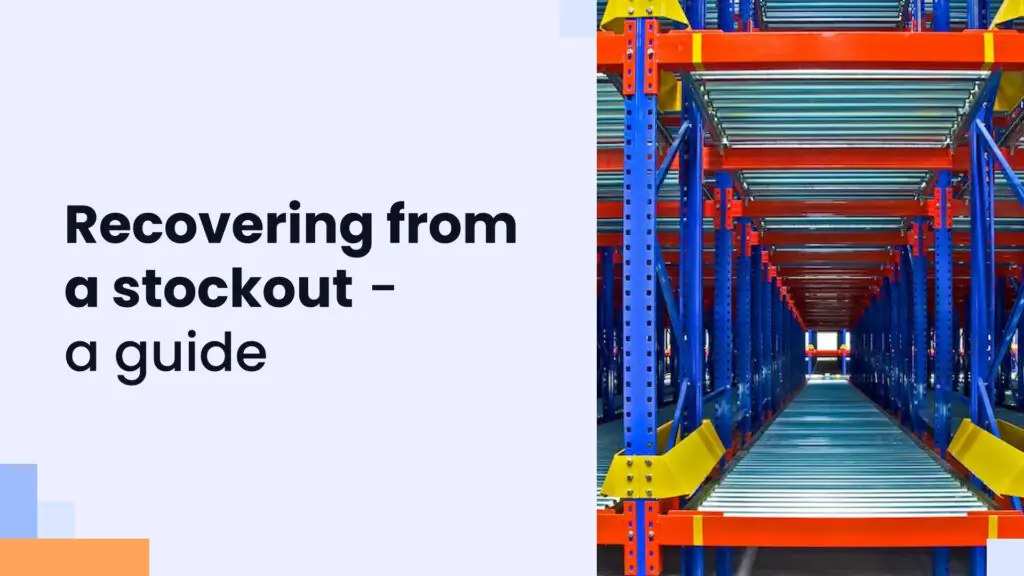Knowing the best way to manage a stockout, communicate with customers, and recover from this unfortunate circumstance is crucial to the success of your eCommerce business.
For every out of stock item that a customer comes across, you’ve likely lost a sale. However, the real danger with out of stock items is not just losing the sale – but losing the customer altogether.
If it’s an essential item or one that many competitors sell, it’s even riskier to put your customers in a position where they can’t get what they wanted from you.
Stockouts are serious, but you don’t need to fret – there are ways to manage out of stock events that can help customers feel more at ease, stay with your business, and even save the sale.
The average out of stock rate in the United States.
Research Gate
No matter how hard you try to avoid them, stockouts are going to happen. In the United States, the average out of stock rate is about 8%. When items are discounted or include a promotion of some kind, the rate rises to 10%.
Not only is saving the sale after a stockout ideal, but more importantly, you want to stay a trusted resource for your customers. Encourage your customers to return and make that purchase, plus future purchases down the road.
What is a stockout?
There are a few different names for a stockout. They are also referred to as an out of stock event, or even OOS, for short. The definition is quite simple: it’s when customers attempt to buy an item that isn’t held in inventory. This could be due to supply chain issues and disruptions, changes in demand, or a retailer struggling to manage their inventory.
Retailers could be missing out on $1 trillion in sales due to stockouts.
Retail Dive
Stockouts are quite costly for retailers, as research finds that they could be missing out on almost $1 trillion sales each year because they didn’t have the inventory on hand.
Subscribe to the eCommerce newsletter for
top industry insights
What causes a stockout?
There are several things that could cause a stockout.
Wrong item count

When an eCommerce business has the wrong item count, that means that the inventory that is physically available is different from how much the business believes is available.
This can create a stockout as there is inaccurate information. The item appeared in the records as being there when it actually wasn’t. These inaccuracies are commonly caused by three issues.
The first is human error. If the counting is happening manually, this could be where someone makes a mistake in counting or logging the inventory.
Secondly, stockouts can happen due to technical errors showing the wrong counts. For example, a piece of software may have had an error that led to a delay in updating the data of current stock levels.
Third, the item count can be inaccurate if there has been shrinkage of stock due to damage or theft.
Ineffective demand forecasting
When there is a surprise surge in the demand for a product, this can lead to that product being out of stock. This is because the anticipated sales did not match the big buyout.
Retailers should forecast their demand based on many moving parts. Seasonal changes will affect demand, as well as other social or environmental events. There can also be unexpected changes in the market.
Understanding demand is key, and being able to forecast and anticipate the levels of stock needed will always be a guessing game. There are ways to have a clearer picture of demand to stay safe, and we’ll go into that below when we explore how to prevent a stockout.
Cash flow management issues
If a company is having issues managing the cash flow and capital, then it may not be able to afford new inventory. This might mean that the business needs to explore how to optimize the cash flow so that there’s always enough inventory purchased as a backup.
You can optimize cash flow management in several ways. These include receiving outside funding from a source such as 8fig, negotiating vendor payment terms, or finding new suppliers altogether.
Essentially, an eCommerce business needs to have enough working capital to allocate to inventory purchasing, and if they don’t, the business won’t run properly.
Vendor problems
If a company’s suppliers don’t send the stock on time or the numbers don’t match what was ordered, then a stockout can happen. If they don’t send enough or send the wrong product, the business won’t be able to match the demand initially forecasted for the product.
The delays associated with fixing issues like these often lead to stockouts. Managing inventory can be a headache when it’s due to events out of your control. You might do everything right, but at the end of the day, if there’s a supply chain issue, there’s nothing you can do.
A way around this (also explained in more detail below) is to purchase safety stock, or more than the anticipated demand, to avoid this problem.
Stock replenishment issues

Being well prepared makes an eCommerce company run successfully. When your inventory is running low, it’s important to notice and replenish it as quickly as possible.
It’s a good idea to have a system in place to ensure that you can maintain the correct level of inventory. This includes how you track sales, count stock, order from your suppliers, and ship and deliver your products.
Of course, it’ll be difficult to replenish stock if you don’t have the working capital or if there are supply chain issues. This is why safety stock is so important. You’ll have something to fall back on in case demand increases or your supply chain is delayed.
Might also interest you:
- The hidden cost of stockouts: A data-driven analysis showing how missing inventory impacts your eCommerce revenue
- Stockouts cause a costly chain reaction to eComm stores. Here’s how to prevent them.
- Proven strategies to take your eCommerce business to the next level
How to tell a customer when a product is out of stock
Customers will be disappointed to learn that a product is out of stock. They will typically have several options: to abandon the purchase altogether, to choose an alternative product, to be notified when the product is back in stock, or to buy the product from another source.
Popular content
- 14 strategies to improve your eCommerce business’s financial health
- 50+ ChatGPT prompts to elevate your eCommerce business
- A guide to pricing your product on Amazon
- 5 marketing metrics all eCommerce businesses should track
- All about Amazon PPC
The worst case scenario for an eCommerce business is that the customer will be so dismayed that they will abandon the store altogether. That’s why it’s important to handle the issue carefully.
Although you can’t avoid the customer’s disappointment due to the stockout, there are ways you can communicate with your customers that will increase their satisfaction and hopefully, keep them as loyal consumers.
The following six tips will ease your customer’s frustration, help them maintain a level of trust in your brand, and support them through the next steps.
1. Let them know ASAP

As soon as you’re aware that the item that has been requested or ordered isn’t available, let your customers know.
The sooner they are aware, the sooner they can decide what to do. The responsibility to provide the items they’ve requested falls on you, the business. Therefore, the responsibility to tell them what’s happened with their order is yours, too.
The best way to let the customer know is by email. Be kind and honest and let them know how to get in touch with you should they have any questions or concerns. You could start with a phrase such as: “Unfortunately, the following product that you ordered is not available.”
2. Apologize and validate their disappointment
There’s no way around it; a stockout is an inconvenience to your customers. They should know that you are aware of that. This will help build trust in your business as they feel that you understand their experience.
Rather than a long-winded apology that makes excuses, be direct. Take responsibility for the delay, and also share that you’re attempting to resolve it (and how). A very simple apology would be: “We apologize for the inconvenience and understand that this would be disappointing for you.”
3. Share the reason for the stockout
Be honest with your customer about what happened. Share what happened, but be careful with the language you use so that it doesn’t sound like an excuse. People have a higher level of respect for businesses that are transparent, so owning the mistake will grant you more respect.
Examples of this are: “We’ve just been informed by our supplier that this item is discontinued and no longer available,” or “We have just become aware that our item count wasn’t correct for this item, and we need to re-order from our vendor.”
4. Give an offer or incentive for an alternative purchase

By offering an alternative or promoting similar products, you may be able to save the sale and not miss out on the customer’s business. You can recommend something that the customer might need or want if you have similar items.
Ideally, you can offer them a discount for the recommended product so they feel like they’re getting a good deal. You can also give them a coupon for future purchases.
5. Share important information about refunds and customer service
In the first communication you have with the customer about the out of stock item, Be sure that you are clear about how the refund process will work and how customers will be reimbursed.
Include the time frame for the refund and also share details of how to contact customer service if they have any questions. Give them all the information that they will need so they don’t have to contact your business themselves to ask these kinds of questions.
An example of this would be, “We will refund your full payment in the same way that you made the purchase. Please allow up to 3 business days to receive your money. If you have any questions about this process, contact our customer service team.” Provide accurate contact details for your business so customers have somewhere to turn for assistance.
6. Notify the customer when the product is back in stock
In the case that the item is going to be replenished, let the customer know when it will be back in stock. You might already know when the product will be available at the time of your first communication. If so, share that information with the customer so that they’re aware that they can wait and still receive the item.
Otherwise, you can send an email to let them know that the item is back in stock. Make it easy for them by sharing a link to purchase it instantly.
How to recover from a stockout
We’ve already gone into how to communicate with your customers regarding stockouts. Below are more tips to manage out of stock products and save your sale.
1. Share if product is temporarily or permanently unavailable

There is a huge difference for a customer if a product is out of stock because it has been discontinued, or if it is temporarily unavailable. Make this clear on your website so customers won’t have to search for the answer.
Customers should be clearly told whether a product is out of stock temporarily, with the chance to get it in the future, or if there’s no chance of purchasing it from you.
If the product will be available again eventually, make it possible for them to save the product to a wishlist or receive a notification when a temporarily out of stock item comes back in. This gives you a better chance of making the sale despite the stockout. It can also satisfy the customer and build trust in your business.
However, if there is no option for customers to get this product, it’s important to let them know. Remove the product from your eCommerce website as soon as possible. You can also give them a recommendation for another similar product.
2. Shift your marketing strategy to alternative products
Even if you go out of stock you don’t have to miss out on the sale entirely. Recommending an alternative product on the original product page can work wonders. Many e-commerce businesses do this and continue to make sales.
If you decide to do this, make sure your advertising and marketing campaigns are relevant. Don’t continue to spend valuable marketing dollars on a sold-out product. That’s a huge waste of resources. Besides, continuing to drive customers to your store with the intention of buying a product that is out of stock is a bad business strategy. It can actually harm your business.
If you have a marketing budget, you can invest in a new campaign for a product that you do have in stock. This can help you recover from any lost sales, too.
3. Get customers their money back
If customers have paid for a product that is out of stock, make sure you have a clear and simple process to get them their money back. It can harm your business’ reputation if customers lose money on a product that doesn’t arrive as expected.
The refund process shouldn’t take too long and customers should be aware of what’s going on with the process. Avoid a lengthy back and forth communication with customers about how to get their money back. This can disappoint them even more, and they’ll be less likely to purchase from you in the future.
You can also create other options for customers to get credit for a similar product which can also save the sale.
4. Make the out of stock product less visible

Sometimes, you may want to keep the product listing live on your eCommerce website, particularly if the product is only out of stock temporarily. In that case, make sure that the product is pushed to the bottom of the category page and search results. Customers don’t want to search for an item and see that the first few items are out of stock. They might give up and navigate away from your store.
If the out of stock products appear lower down on the page, it will lead to less disappointment. Customers might even choose to purchase an alternative option on their own, saving the sale and the customer.
5. Let customers pre-order or choose a longer shipping time
Another tactic to salvage a sale is to give customers the option of pre-ordering the out of stock product. This ensures that they still make the purchase. When potential customers just add the product to a wishlist or receive a notification when it’s ready, they may not decide to buy in the end.
You may want to advertise the product differently in this case. Rather than “out of stock”, you can say “pre-order”. Be sure to share how long it is estimated to take to arrive so that the customer feels confident that they’ll get the item. You can also give customers the incentive to pre-order by giving them a discount on the product. For example, “pre-order now and save 20%”.
Another option is to set the product status as having a “longer shipping time” rather than directly stating that it is out of stock. Again, only utilize this tip if you know for sure that the item will be available at your fulfillment center soon. Give customers a reasonable time frame, too.
If you won’t have the product in stock for three more months, the wait time might be too long for this strategy. However, 30 days is a wait that many people would agree to. These two options help to secure the sale instantly, even if the product isn’t on hand.
Focus on stockout avoidance
Of course, the best solution to a stockout is to avoid it altogether. Preventing stockouts means investing in inventory management systems, working with partners, streamlining your supply chain, and purchasing safety stock. All of those things require working capital.
That’s where 8fig comes in. We offer eCommerce sellers fast, flexible, and continuous funding solutions that help them stay in stock and grow their business. Plus, our free suite of planning tools helps you forecast demand and stay on top of your supply chain. Sign up for a personalized Growth Plan from 8fig and never go out of stock again!
Have article ideas, requests, or collaboration proposals? Reach out to us at editor@8fig.co – we’d love to hear from you.
- How financial technology is transforming online shopping
- Mastering global vendor payments: How to streamline payouts and improve supplier relations
- 20+ actionable eCommerce hacks to boost your business
- Survey reveals: The number one goal of eCommerce sellers (2024-2025)
- A complete guide to designing an ideal eCommerce landing page
Subscribe to the eCommerce newsletter for
top industry insights
to our blog
Read the latest
from 8fig

Personalization isn’t just a trend – it’s the key to eCommerce success. Discover how tailored strategies drive conversions, foster loyalty, and set your store apart.

Video ads can make or break your eCommerce success. Learn five essential strategies to create high-converting campaigns that captivate and convert.

Crack the code to funding your eCommerce business with this step-by-step guide, and learn how to secure the capital you need to grow while staying on top of your strategy.
